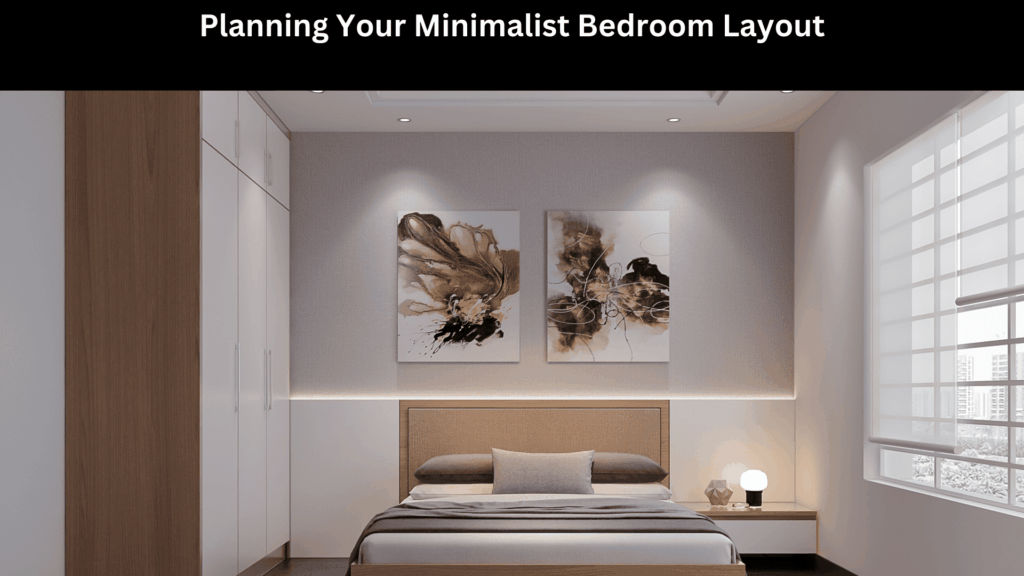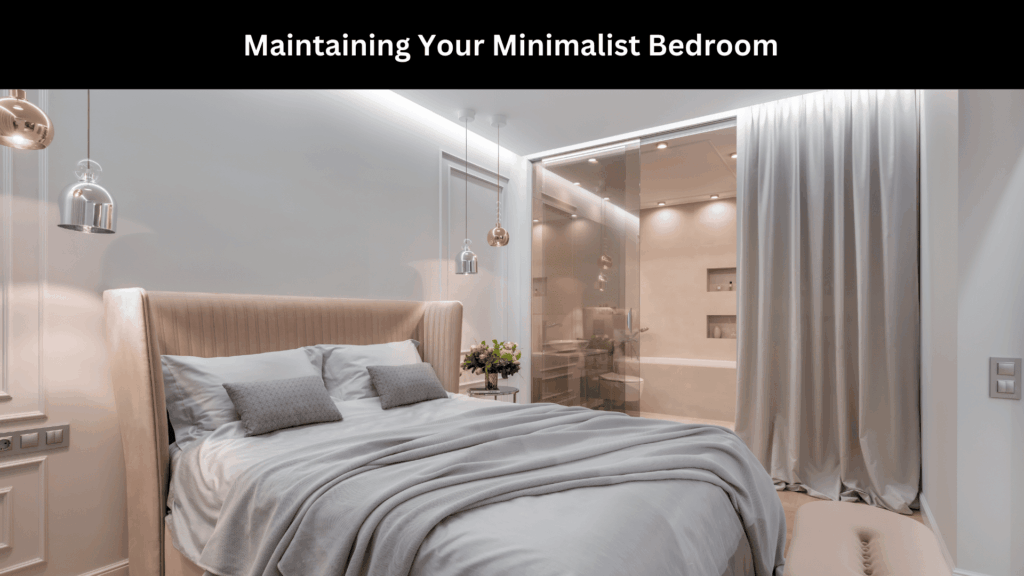Minimalist bedroom interior design can transform your space into a serene, stylish retreat. Discover expert tips, layouts, colors, furniture ideas, and decor strategies to achieve the perfect minimalist bedroom.
Creating a bedroom that embodies Minimalist bedroom interior design is more than just a trend; it’s a lifestyle choice. Minimalism isn’t about stripping away personality—it’s about emphasizing clarity, simplicity, and functionality while creating a peaceful sanctuary. In today’s fast-paced world, your bedroom should be a haven where stress melts away, and calm prevails. From smart layouts to subtle decor choices, every element contributes to a cohesive, serene environment.
Contents
- 1 Understanding Minimalist Interior Design
- 2 Planning Your Minimalist Bedroom Layout
- 3 Choosing a Minimalist Color Palette
- 4 Essential Furniture for Minimalist Bedrooms
- 5 Lighting Techniques for Minimalist Bedrooms
- 6 Textiles and Accessories
- 7 Incorporating Art and Decor in a Minimalist Bedroom
- 8 Flooring Options for Minimalist Bedrooms
- 9 Technology Integration in Minimalist Spaces
- 10 Budgeting for a Minimalist Bedroom Makeover
- 11 Maintaining Your Minimalist Bedroom
- 12 Frequently Asked Questions
- 13 Conclusion
Understanding Minimalist Interior Design

Minimalism in interior design focuses on reducing clutter and enhancing functionality while maintaining aesthetic elegance. This style prioritizes clean lines, open spaces, and purposeful furnishings. Its roots trace back to early 20th-century modernism, heavily influenced by Japanese and Scandinavian design philosophies.
Origins of Minimalism in Interior Spaces
Minimalist design emerged from a need to counter the chaos of over-decorated spaces. Japanese minimalism emphasizes simplicity, natural materials, and a connection to nature. Scandinavian minimalism combines functionality with warmth, using neutral colors and practical furniture. Both approaches share the principle that “less is more,” creating spaces that feel calm and organized.
Core Principles of Minimalist Design
At the heart of minimalism are three key principles:
- Simplicity: Prioritize essential items; every piece should serve a purpose.
- Neutral Palette: Colors are kept muted or monochromatic to enhance tranquility.
- Decluttered Environment: Avoid overcrowding; storage solutions are sleek and hidden.
Implementing these principles ensures your bedroom is not only visually appealing but also promotes mental clarity and restful sleep.
Planning Your Minimalist Bedroom Layout

A well-thought-out layout is the foundation of a minimalist bedroom. Strategic placement of furniture, thoughtful use of open space, and clear pathways contribute to both functionality and aesthetics.
Space Optimization Techniques
Use multifunctional furniture to maximize space. Platform beds with storage drawers or wall-mounted desks help keep the room uncluttered. Consider furniture with clean lines and compact designs to create the illusion of more space.
Decluttering and Functional Storage
Clutter is the enemy of minimalism. Incorporate built-in wardrobes, under-bed storage, and minimalist shelving. Keeping surfaces clear not only looks cleaner but also promotes mental calmness. Seasonal items can be rotated or stored out of sight, maintaining the room’s serene vibe.
Choosing a Minimalist Color Palette
Color plays a pivotal role in minimalist design. It influences mood, perception of space, and overall aesthetics.
Popular Color Schemes for Minimalist Bedrooms
Neutral tones dominate minimalist spaces. Whites, beiges, soft greys, and muted pastels create a calm environment and provide a versatile backdrop for furniture and decor. Using subtle variations of a single color adds depth without compromising simplicity.
Psychological Impact of Colors
Colors affect mood and energy. White reflects light and enhances openness, while soft greys induce relaxation. Pastels subtly enrich a space without overwhelming it, creating a soothing, stress-free atmosphere.
Essential Furniture for Minimalist Bedrooms
Furniture selection in minimalist bedrooms is about balancing functionality with sleek aesthetics. Each piece should serve a clear purpose.
Bed Selection and Placement
Platform or low-profile beds are ideal for minimalist spaces. Place the bed to maximize flow and accessibility, ideally away from cluttered walls or obstructed windows.
Storage Solutions
Incorporate hidden storage like under-bed drawers or built-in closets. Minimalist shelving can showcase only a few essential items, keeping visual clutter at bay.
Seating and Additional Furniture
A single chair or a simple bench can provide comfort without overcrowding the room. Avoid excessive or bulky pieces, focusing instead on streamlined designs.
Lighting Techniques for Minimalist Bedrooms

Lighting sets the mood and enhances functionality in any bedroom.
Maximizing Natural Light
Natural light brings life and openness to a minimalist bedroom. Use sheer curtains, strategically place mirrors, and avoid heavy window treatments to let light flow freely.
Artificial Lighting Options
Dimmable LED lights, pendant lights, and sleek floor lamps provide flexibility and complement minimalist aesthetics. Smart lighting solutions can also adjust brightness automatically, maintaining a serene environment.
Textiles and Accessories
Textiles and minimal decor add warmth and texture to minimalist bedrooms without cluttering the space.
Choosing Minimalist Bedding
Opt for bedding in neutral tones with subtle textures. Avoid bold patterns that can distract from the clean design. Linen, cotton, and lightweight duvets create a soft, inviting feel.
Curtains, Rugs, and Throws
Select simple rugs, understated throws, and plain curtains to maintain cohesion. Textures should enhance the space without drawing excessive attention.
Incorporating Art and Decor in a Minimalist Bedroom
Minimalist decor focuses on quality over quantity.
Selecting the Right Wall Art
Choose one statement piece or a cohesive small gallery. Avoid overcrowding walls; the artwork should complement the room’s serene feel.
Minimalist Plants and Greenery
Incorporate low-maintenance plants like succulents or snake plants. They purify the air and add a touch of life without overwhelming the space.
Flooring Options for Minimalist Bedrooms

Flooring contributes significantly to the room’s visual flow.
Wood and Laminate Floors
Light-colored wood or laminate flooring adds warmth while maintaining simplicity. It blends seamlessly with neutral color palettes.
Rugs and Carpets
Select minimal rugs with soft textures. Place them strategically to add comfort and demarcate spaces without adding visual clutter.
Technology Integration in Minimalist Spaces
Modern minimalist bedrooms can include technology without compromising aesthetics.
Smart Lighting and Automation
Use discreet smart devices, automated lighting, and minimalist switches. These features enhance convenience while maintaining clean lines.
Cable Management Solutions
Conceal wires with cable organizers, hidden channels, or furniture with built-in compartments. Maintaining neatness is essential in minimalism.
Budgeting for a Minimalist Bedroom Makeover
You don’t need a huge budget to achieve minimalist elegance.
High vs. Low Budget Approaches
Invest in key pieces like a quality bed and mattress. Save on accessories or DIY decor to reduce costs.
DIY and Upcycling Ideas
Repurpose old furniture, repaint, or craft simple decor items. This keeps costs down and allows personalization while maintaining a minimalist vibe.
Maintaining Your Minimalist Bedroom

Consistency is key to keeping your bedroom minimalist and serene.
Cleaning and Organization Tips
Routine cleaning and decluttering help maintain order. A weekly check to remove unnecessary items preserves the minimalist aesthetic.
Seasonal Refresh Ideas
Rotate bedding, add seasonal textures, or slightly rearrange decor to keep the space feeling fresh without clutter.
Frequently Asked Questions
What defines a minimalist bedroom?
A minimalist bedroom emphasizes simplicity, clean lines, functional furniture, neutral colors, and clutter-free spaces.
How do I make a small bedroom minimalist?
Focus on multifunctional furniture, light colors, and smart storage solutions to create the illusion of more space.
Can I mix colors in a minimalist bedroom?
Yes, but stick to neutral or muted tones. Avoid bold contrasts; subtle variations enhance minimalism.
What are must-have furniture pieces?
A platform bed, built-in or hidden storage, a single chair or bench, and minimal shelving.
How to incorporate personal items without clutter?
Limit decor to a few meaningful pieces, use hidden storage, and rotate items seasonally.
How often should I declutter my bedroom?
At least once a month; maintain minimalism by regularly removing unneeded items.
Conclusion
Adopting Minimalist bedroom interior design transforms your bedroom into a peaceful sanctuary. By embracing simplicity, decluttering thoughtfully, selecting functional furniture, and adding subtle textures and lighting, your bedroom becomes a haven of calm and style. Whether you have a compact city apartment or a spacious home, these strategies help you achieve the perfect minimalist retreat, combining elegance, functionality, and serenity.